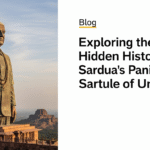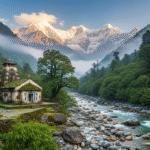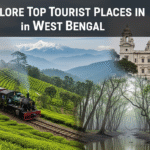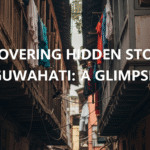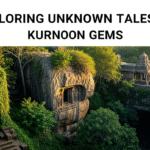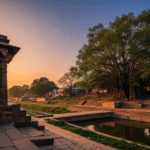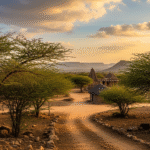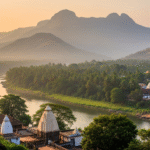In the quiet corners of Bihar, in northeast India, Darbhanga shines with ancient traditions and art. This place has a rich history that is not well-known globally. Madhubani paintings are a key part of Darbhanga’s culture. These vibrant folk arts gained worldwide attention by accident after a disaster. In 1934, William G. Archer, a British officer, found the beautiful Madhubani art right after a huge earthquake in Bihar.
Darbhanga’s history is filled with more than just Madhubani paintings. It has many hidden stories full of cultural depth. When people look closer, they find a history alive with artistry and wisdom. The city’s legacy shows the strength and creativity of its people. This includes women who made natural dyes for their art and today’s artists keeping traditions alive amid modern changes.
Our story takes us into Darbhanga’s alleys and courtyards, exploring its heritage. As we look into Darbhanga’s past, we find stories that are alive with culture. These stories are kept by generations who add to Darbhanga’s culture, art, and education.
Social Endeavors and Education: A Glimpse into Darbhanga’s Modern Contributions
Key Takeaways
- The accidental discovery of Madhubani paintings post-earthquake in 1934 marking an important event in Darbhanga history.
- Madhubani art, deeply embedded in Darbhanga culture, showcases the creative continuity and adaptability of the region’s artists.
- A shift from traditional natural dyes to market-sourced colors reflects the evolution within Darbhanga heritage.
- Famed artists such as Ganga Devi symbolize the advanced reach and recognition of Darbhanga’s art forms.
- The sectored styles of Madhubani paintings mirror the diverse narratives and hidden stories of Darbhanga.
- Geometric patterns and symbolic motifs narrate the deep-seated religious and cultural beliefs held within Darbhanga heritage.
- The preservation of ancient art forms juxtaposes the pressing challenges and potential opportunities for Darbhanga’s future.
Darbhanga’s Cultural Tapestry and Historical Significance
Darbhanga’s culture is rich and historic. It has beautiful landscapes and unique religious practices. The city is famous for Madhubani paintings and cultural festivals.
Darbhanga has a big role in Bihar’s culture and economy. It hosts Lalit Narayan Mithila University, a top school. The city’s economy is strong due to farming of rice, jute, sugarcane, and wheat.
The legends of Darbhanga are part of its fabric. Madhubani paintings tell stories of love and gods. These artworks show Darbhanga’s deep culture.
Many temples, mosques, and gurudwaras fill the city. They show its religious diversity. Madhubani art has gone from house walls to fabrics worldwide.
In short, Darbhanga is not just a place. It’s a vibrant piece of India’s culture. It keeps history alive and teaches us through its stories and art.
Social Endeavors and Education: A Glimpse into Darbhanga’s Modern Contributions
The Darbhanga community is rich in history and vibrant in its social and educational efforts. It’s in Bihar’s heart. Darbhanga shines as a community support beacon. The Anganwadi Primary School and Vivekanand Law Academy drive this.
Anganwadi Primary School’s Community Efforts
The Anganwadi Primary School is leading educational progress in Darbhanga. It focuses on underprivileged kids, showing true community support. The school uses many programs for growth, playing a big part in lifting the Darbhanga community.
Places like Vivekanand Law Academy help a lot with resources and volunteers. Their efforts make Darbhanga’s social fabric stronger through learning. This teamwork helps young minds grow well in this community.
Vivekanand Law Academy’s Charitable Initiatives
Vivekanand Law Academy boosts Darbhanga charitable events with education and legal help. Working with the International Youth Development Foundation, the academy gives needy kids in Darbhanga educational materials and sports gear. This supports both learning and health.
These efforts show the academy’s deep social responsibility. They aim to create a caring space for young people to succeed.
https://www.youtube.com/watch?v=_kpd1x6c8_I
Anganwadi Primary School and Vivekanand Law Academy highlight Darbhanga’s modern contributions. They show how education can change a community. Below is a table of their educational efforts, showing their big impact:
| Institution | Programs Offered | Community Impact |
|---|---|---|
| Anganwadi Primary School | Educational advancement for underprivileged children | Significant improvement in academic performance and personal development |
| Vivekanand Law Academy | Charitable distributions, legal education seminars | Enhanced legal awareness and educational equity |
This table shows how these places commit and play key roles in supporting the Darbhanga community.
Reflections of Independence: Literature that Shapes Darbhanga’s Identity
In the heart of India, Darbhanga shines brightly. It stands out for its farming and economic work. It also shows off the rich culture of India through its Darbhanga independence literature. This literature is a key part of the city’s culture and learning. It connects deeply with the Indian freedom movement.
Darbhanga’s stories fill us with the bravery and smart plans that helped India become free. These stories help young people understand and respect the past. They grow up loving their country. Darbhanga’s writers capture the area’s role in fighting for freedom. They inspire both local people and scholars.
Darbhanga has libraries and schools that are proud of their book collection. This includes “12 Essential Books for Young Minds on India’s Fight for Freedom”. These books tell about the fighters’ bold spirit. They also explain how the Indian freedom movement worked. These books are very important for teaching young people.
Darbhanga loves its history and learning. It holds cultural festivals and readings often. These events highlight Darbhanga independence literature and national heroes’ stories. They celebrate freedom and make people proud of where they’re from. The stories told are very important. They help bring the city together.
Darbhanga mixes its farming heritage with its literary gifts. This creates a special cultural scene. It draws in tourists, scholars, and writers. They come to learn about the brave history and the unique culture of this area.
Hidden Stories of Darbhanga: Uncovering the City’s Legends and Folklore
Darbhanga is known for its rich history and culture. It has stories of ancient heroism and strange traditions. These Darbhanga legends help us learn about the past. They are still meaningful today, drawing in travellers and scholars.
In Darbhanga, there are many old stories to find. People talk about heroes and wise mystics who made the area special. These stories make Darbhanga more than a place in history. They show it as a treasure of dreams and talks across ages.
“Mysteries of Darbhanga are not just tales from the past; they are lessons that guide the present and inspire the future.”
One famous story is about a mystic who knew the future and was loved by kings. Such Darbhanga folklore is not only captivating. It also reveals the era’s social and political life. These stories let us see history in a new way.

- The Legend of the Sacred Grove: A tale of a woodland blessed by the gods, where no evil dare tread.
- The Mystic of Mithila: Chronicles the life of a sage whose wisdom was sought after by both mortals and deities.
- The Royal Secret Keeper: Explores the intrigue surrounding a royal advisor in the ancient Darbhanga court who was believed to possess supernatural abilities.
Looking into these tales is like walking through a maze of culture and old wisdom. It is an enlightening and magical journey. Understanding the hidden meanings in these stories teaches us about life and values in Darbhanga through time.
| Legend | Theme | Impact on Culture |
|---|---|---|
| The Enchanted Lake | Spiritual purity and divine protection | Influences local rituals and festivities |
| The Vanishing Palace | Historical upheavals and royal mysteries | Shapes narratives around heritage conservation |
| The Weaver’s Song | Folk wisdom and the craft of storytelling | Preserves traditional crafts and oral history |
The hidden stories of Darbhanga draw attention worldwide. Folklore and stories break through time and places. They are not just old tales; they enrich Darbhanga’s culture and history today.
Darbhanga’s Architectural Heritage: Merging Aesthetics with History
In the heart of Bihar, Darbhanga shows off its rich architectural past. The famous Darbhanga Fort and many old monuments stand tall. They show the area’s long history with art and building.
The city works hard to keep its important places safe. It takes great care of these sites. Many groups help by studying and keeping records about them.
Exploring the Majesty of Darbhanga Fort
The majestic Darbhanga Fort is very important in Bihar. It shows off ancient building skills. Its strong walls and detailed designs share old stories, drawing in scholars and tourists.
The Artistry of Ancient Temples and Monuments
The Darbhanga temples are important for culture and religion. They are beautiful and show the area’s art skills. They are not just places to pray but also keep the area’s culture alive.
The Bihar Research Society and others help keep these treasures safe. They make sure we don’t forget Darbhanga’s rich history. Local families and archives also help a lot.
Groups like the University of California Press and some grants support this work. They help the world see why Darbhanga’s old places are important. This attention is good for protecting and learning about them.
Looking at Darbhanga’s buildings helps us understand its past. It shows us the skill and art passed down over time. Darbhanga, with its forts and temples, shines as a place of history and beauty in India.
The Role of Darbhanga in India’s Freedom Narrative
Darbhanga played a big role in India’s fight for freedom. It is located in the heart of Bihar. People from Darbhanga helped a lot in India’s fight to be free from colonial rule. Their efforts made a big difference in the freedom movement.
There are many stories of courage from Darbhanga during the freedom struggle. Many plans to fight for independence started in Darbhanga. People found courage here to join the fight for freedom.

People from Darbhanga were very involved in the fight for independence. They really cared about the cause. The region was full of smart people who wanted freedom. They did a lot to help fight the British.
| Event | Details | Date |
|---|---|---|
| Formation of Study Groups | Local intellectuals and activists in Darbhanga formed study groups to discuss colonial impacts and indigenous strategies for self-governance. | 1916 |
| Nationalist Processions | Massive processions were organized in Darbhanga, resonating with calls for freedom and displaying unity among different communities. | 1920 |
| Establishment of Freedom Centers | Centers for gathering, planning, and executing freedom activities were established covertly across Darbhanga. | 1930 |
Darbhanga’s active role in the freedom fight was very important. People here did a lot for India’s freedom. Today, we remember and honor their efforts. They are a big part of Darbhanga’s history and India’s fight for freedom.
Preserving Darbhanga’s Languages and Crafts in the Modern Age
Darbhanga is known for its old monuments and stories. But it’s also known for its Darbhanga traditions. These include special languages and crafts. Keeping these traditions alive is key to keeping Darbhanga’s culture strong.
Madhubani painting is a well-known craft from Darbhanga. It became famous in the 1970s. These paintings show daily and spiritual life. They are made in five styles: Bharni, Tantric, Katchni, Godna, and Khobar.
Maithili is the language of the Maithil people. It shows how rich Darbhanga’s language is. Just like crafts, keeping languages like Maithili alive is important. They help keep Darbhanga’s culture going from one generation to the next.
Overview of Madhubani Painting Characteristics
| Style | Features | Usage |
|---|---|---|
| Bharni | Filled forms with bold colors | Celebratory and religious events |
| Katchni | Delicate line drawings primarily in black and red | Day-to-day life depiction |
| Tantric | Symbols and patterns used in rituals | Tantric practices and ceremonies |
| Godna | Depictions resembling tattoos | Social and cultural stories |
| Khobar | Mandalas and auspicious symbols used in marriages | Wedding ceremonies |
By working on both language preservation and craft promotion, Darbhanga can keep its culture alive. This lets traditions like Madhubani painting and the Maithili language not just survive but grow. It ensures Darbhanga’s unique culture is celebrated and kept alive.
Darbhanga’s Food Lore: Culinary Traditions Embedded in Heritage
The journey of food in Darbhanga is colorful and varied. It mirrors the area’s rich culture. Home to a gastronomic heritage, this place boasts royal recipes and lively street food. Both are rooted in Darbhanga’s social heritage.
The Royal Cuisines of Darbhanga
The royal culinary traditions of Darbhanga showcase the region’s grand past. These dishes, rich in history, offer more than taste. They capture Darbhanga’s culinary spirit. Each meal reflects the luxury of Darbhanga’s royal era.
Street Food: A Testament to Darbhanga’s Social Fabric
In Darbhanga, street food brings people together. It fills the bustling markets with numerous tastes. This is where Darbhanga’s spirit truly shines. The food is about community and fellowship, adding to the city’s social heritage.
Both royal and street foods in Darbhanga maintain tradition while adapting to new tastes. For a deeper understanding of India’s culinary culture, W. H. Sleeman’s work is great. It connects modern culinary practices with historical stories.
Linking Darbhanga’s Past to its Future: Challenges and Opportunities
Darbhanga is working hard to keep its culture while growing modern. It faces heritage challenges but looks to a better Darbhanga’s future. This mix of old and new offers great chances to use history for today’s progress.
Darbhanga’s culture and economy benefit from its history, like the famous Madhubani paintings. These artworks are not just beautiful. They also help people make money in changing times.
| Madhubani Painting Aspect | Details |
|---|---|
| Discovery Year | 1934 |
| Material Used | Twigs, matchsticks, natural dyes from plants |
| Styles | Tantrik, Kohbar, Bharni, Godna, Katchni |
| Symbolism | Fish, peacock, elephants, sun, moon, etc. |
| Famous Artists | Mahasundari Devi, Bharti Dayal |
Connecting old arts to new markets helps keep the culture alive. This brings money and keeps traditions going. Schools teaching heritage help a community value its history. Over 200,000 students have learned about local culture and history this way.
Darbhanga is faced with heritage challenges as it grows. Urban sprawl and money issues threaten old sites and traditions. We need clever plans and caring city designs to keep Darbhanga’s spirit while it expands.
In the end, Darbhanga aims to blend history with a bright future. Keeping history in mind is key as the city changes. This balance might shape Darbhanga’s future.
Conclusion
Darbhanga’s story shows us the beauty of India’s culture and history. This city has more than a million people. It carries the past forward with pride. Places like Lalit Narayan Mithila University and Kankali Temple show its love for learning and amazing architecture. Celebrating Darbhanga means exploring its past. It’s about understanding its arts and honoring people like Vidyapati and Ramdhari Singh “Dinkar”.
Darbhanga’s heart isn’t just in its old buildings. It also beats in dances like Jata Jatin and its folk songs. The city thrives on farming things like rice and wheat. This fuels its lively local crafts like the Darbhanga-Mithila painting. Festivals like Sama Chakeva bring everyone together. They add to Darbhanga’s rich traditions.
Keeping Darbhanga’s spirit alive is key. As it grows, it keeps its heritage and welcomes the future. It’s changing fast, blending the past with new dreams. This change celebrates Darbhanga’s unbreakable spirit. It’s our job to protect this spirit and keep it going for the future. We must ensure Darbhanga’s stories are told for years to come.
FAQ
What are some lesser-known facts about Darbhanga’s heritage?
Darbhanga has a rich royal past. This includes the grand Darbhanga Fort. It’s also known for its role in the freedom movement. There are hidden tales of heroism and culture not many know about.
How does Darbhanga’s culture reflect its historical significance?
The culture in Darbhanga shows its royal history and fight for freedom. Folklore, music, and Mithila art tell historical stories. They show how history shaped Darbhanga’s society.
What social and educational contributions are currently happening in Darbhanga?
In Darbhanga, schools and academies help the needy. They provide education and resources. This improves the community and builds a sense of responsibility.
Why is literature important to Darbhanga’s identity?
Literature captures Darbhanga’s historical spirit. It shares stories of India’s freedom struggle. These stories are key to the city’s cultural identity.
What kinds of legends and folklore are associated with Darbhanga?
Darbhanga has many stories of bravery, wisdom, and supernatural beliefs. These tales, rooted in history, give insight into the city’s values and past.
Can you describe Darbhanga’s architectural heritage?
The city boasts Darbhanga Fort, temples, and monuments. They show skilled craftsmanship and tell tales of the past. These buildings are a big part of its history.
What was Darbhanga’s role in India’s freedom narrative?
Darbhanga was crucial in India’s fight for freedom. It was home to freedom fighters and thinkers. They helped free India from British rule.
How is Darbhanga preserving its languages and crafts?
Darbhanga is saving its unique languages and crafts. This includes Maithili and Mithila painting. Workshops and festivals help keep these traditions alive today.
What is special about Darbhanga’s cuisine?
Darbhanga’s food comes from royal recipes. These dishes are unique and tasty. The city’s street food shows its heritage and community life.
How is Darbhanga balancing modern development with heritage preservation?
Darbhanga balances growth and preserving its past. It uses sustainable methods and promotes cultural tourism. This keeps its history alive for everyone.
Why is it important to keep exploring Darbhanga’s hidden stories and traditions?
Learning about Darbhanga’s secrets enriches our view of its culture. It keeps the region’s history alive. This makes the people proud and connected.

